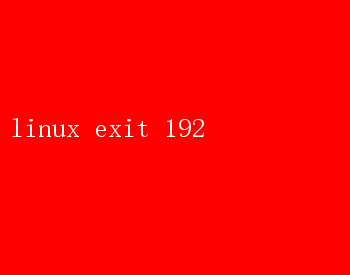
Linux Exit Code 192: Deciphering the Enigma Behind the Termination
In the vast, intricate world of Linux system administration and programming, every detail counts. Among these myriad details, exit codes stand as silent yet significant messengers, conveying the termination status of processes and scripts. While most exit codes are well-documented and straightforward, there are some that can evoke curiosity and sometimes frustration, such as exit code 192. This article aims to unravel the mystery behind Linux exit code 192, providing a comprehensive understanding of its origins, implications, and troubleshooting strategies.
Understanding Exit Codes in Linux
Before diving into the specifics of exit code 192, its essential to grasp the fundamental concept of exit codes in Linux. An exit code, also known as a return code or exit status, is a numeric value that a program or script returns to the operating system upon termination. This value serves as a concise way to communicate whether the program executed successfully or encountered an error. By convention:
- Exit Code 0: Indicates successful completion.
- Non-zero Exit Codes: Indicate various types of errors or anomalies.
The range of possible exit codes is 0 to 255. Values between 1 and 125 are typically reserved for specific errors defined by the shell or user programs. Values above 128 are often used to signify signals that caused the process to terminate abnormally. For instance, exit code 130 indicates that the process was terminated by the`SIGINT` signal(usually due to a Ctrl+Cinterrupt).
Introducing Exit Code 192
Exit code 192 falls within the range of values that are not universally predefined by Linux standards. This lack of standardization means that its meaning can vary depending on the context in which it is used. However, some common patterns and potential causes can be discerned through analysis and experience.
Possible Causes of Exit Code 192
1.Custom Error Handling:
Many programs and scripts include custom error handling mechanisms. Developers may choose to return specific exit codes to signify unique error conditions. Exit code 192 could be one such custom code, used internally within a particular application or script to denote a specific type of failure.
2.Shell Built-ins and Aliases:
Sometimes, exit code 192 might be encountered when working with shell built-ins or aliased commands. Aliases can obscure the true command being executed, and if they are poorly configured, they might result in unexpected exit codes.
3.Subprocesses and Job Control:
In complex scripts or systems where multiple processes interact, subprocesses might terminate with exit code 192 due to issues like resource limitations, signal handling, or errors in inter-process communication.
4.Package Managers and Installers:
Certain package managers or software installers might use exit code 192 to indicate specific failure scenarios. For instance, custom scripts within installation packages could be designed to return this code when encountering a particular set of conditions.
5.Third-party Applications:
Many third-party applications and services run on Linux. These applications might use exit code 192 internally for their own error handling purposes. Understanding the documentation or support resources for these applications is crucial for interpreting this code.
Decoding Context-Specific Meanings
Given the variability in the interpretation of exit code 192, decoding its meaning often requires an understanding of the specific context in which it appears. Here are some strategies for diagnosing and interpreting exit code 192:
1.Check Documentation and Logs:
The first step should always be to consult the documentation of the program or script that returned the exit code. Many programs provide detailed descriptions of possible exit codes in their manuals or help files. Additionally, checking system logs and application logs can provide insights into the conditions leading to the error.
2.Inspect Aliases and Shell Scripts:
If the exit code was returned by a command executed in a shell, inspect any aliases or shell scripts involved. Usethe `alias` command to list aliasesand `type
` to see if a command is aliased. Review the scripts for any
